नमस्कार साथियों क्या आप जानना चाहते है BSC 6th Sem Chemistry Important Questions in Hindi 2024 के बारे में? दोस्तों आपका स्वागत है इस लेख में, हम आपको BSC 6th Semester Chemistry Important Questions In Hindi के साथ BSC 6th Semester inorganic chemistry important questions, BSC 6th Semester organic chemistry important questions, BSC 6th Semester physical chemistry important questions 2024 के बारे में सब कुछ बताएंगे।
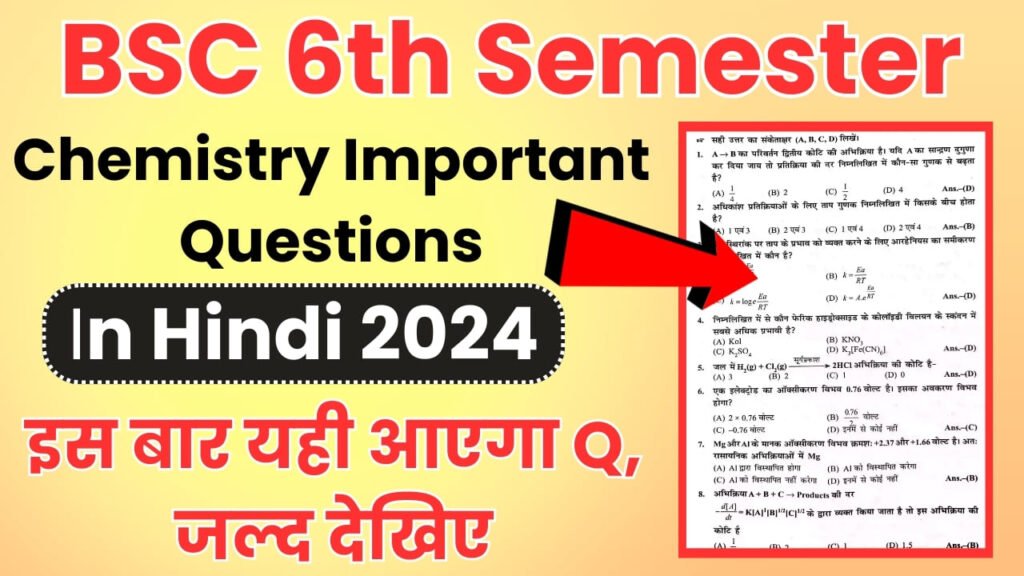
जैसा कि आप जानते हैं Chemistry एक बहुत ही दिमाग लगाने वाला subject है, तो इस लेख में हमने BSC 6th Semester Chemistry Important Questions इकट्ठा किया है जो कि आपको पढ़ने में मदत करेंगे अगर आप इस लेख में बताए हुए Important Questions को एक बार रट लेंगे तो आप समझ लो 60% syllabus cover हो जाएगा, तो BSC 6th Semester Chemistry Important Questions In Hindi की पूरी सूची पढ़ने के लिए इस लेख को अंत तक जरूर पढ़ें ।
यह BSC 6th Semester Chemistry Important Questions के महत्वपूर्ण प्रश्न 2024 प्रतिष्ठित संस्थानों के अनुभवी शिक्षकों द्वारा तैयार किए गए हैं, इन प्रश्नों के पेपर में आने की अधिक संभावना है, इसलिए इन्हें अच्छी तरह से तैयार करें।
Contents
BSC 6th Sem Chemistry Important Questions In Hindi 2024
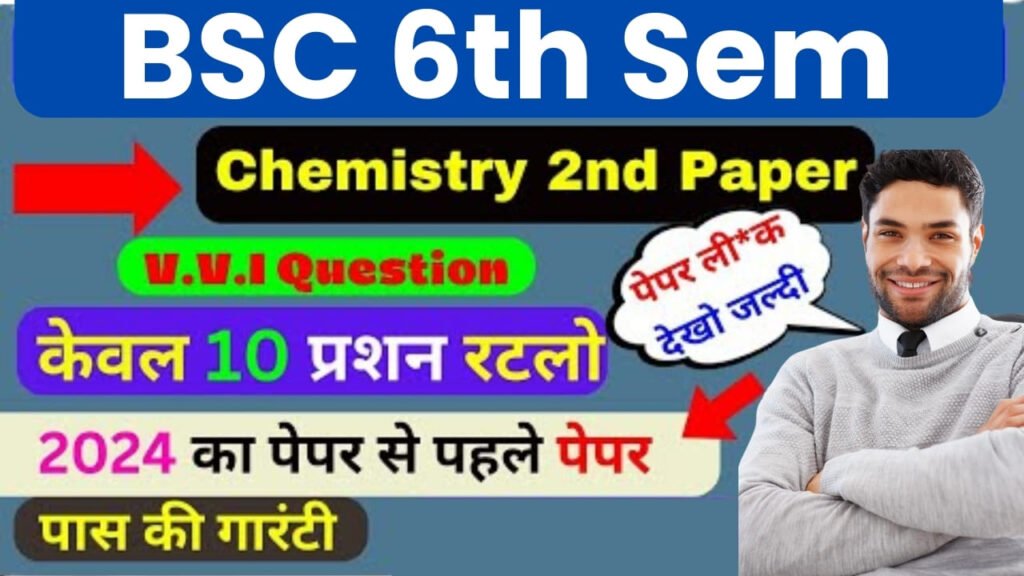
Q1: अम्ल और अम्लकीय अण्डों के मूल्यनीति में क्या अंतर होता है? (Difference between acids and acid anhydrides)
Q2: सरल, सम्मिश्र और परिकलित उपकरणों के बीच अंतर क्या है? (Difference between simple, mixed, and compound apparatus)
Q3: निर्मिति और संयोजन की प्रक्रिया में अवधारणा क्या है? (What is the concept of fabrication and assembly process?)
Q4: सांद्रता के विभिन्न प्रकार और उनके विशेषताएँ क्या हैं? (Various types of densitometer and their features)
Q5: आधुनिक संयंत्रों में उपयोग की जाने वाली अपशिष्ट का प्रबंधन। (Management of waste used in modern industries)
Q6: निस्पंदीकरण और ध्वनिकरण के प्रमुख विभाजन क्या हैं? (Principal divisions of disinfection and sterilization)
Q7: भारतीय धातुरसायनिकी के विकास में योगदान। (Contribution to the development of Indian metallurgy)
Q8: खनिज और उनके खनन के प्रमुख स्रोत। (Minerals and their major sources of extraction)
Q9: धातुओं की संरचना और उनके लक्षण। (Structure and characteristics of metals)
Q10: सूचक अध्ययन और उसके महत्व। (Indicator study and its significance)
Q11: उच्च तापमान धातु ग्रहण की प्रक्रिया। (High-temperature metal extraction process)
Q12: स्नायुशास्त्र में अभ्यासित सिद्धांत। (Principles studied in metallurgy)
Q13: लौह का प्रकार और उसकी विशेषताएँ। (Types of iron and its characteristics)
Q14: क्लॉरोफार्म की तैयारी और उसकी उपयोगिता। (Preparation and utility of chloroform)
Q15: स्टेनलेस स्टील की विशेषताएँ और उसका उपयोग। (Characteristics of stainless steel and its uses)
Q16: सोडियम, पोटेशियम, बरियम और कैल्शियम की तैयारी। (Preparation of Sodium, Potassium, Barium, and Calcium)
Q17: धातु निकासी और उसकी उपयोगिता। (Metal extraction and its utility)
Q18: धातुरसायनिकी में कठिनाईयां और उनके समाधान। (Difficulties in metallurgy and their solutions)
Q19: धातु अधिग्रहण और प्रक्रिया का विवरण। (Metal absorption and process description)
Q20: विभिन्न धातुओं के लिए विशेष उपकरण। (Special equipment for different metals)
Q21: धातुरसायनिकी के नवाचार। (Innovations in metallurgy)
Q22: एग्जीडीजिटल उत्पादों का उपयोग। (Use of Exdigital products)
Q23: धातुओं की वैद्युतीकरण प्रक्रिया। (Metal electrification process)
Q24: कृत्रिम और स्वाभाविक धातुओं का मूल्यांकन। (Evaluation of artificial and natural metals)
Q25: धातुरसायनिकी में प्रयुक्त रेखांकन। (Lineation used in metallurgy)
Q26: धातुओं की अभियांत्रिकी। (Metal engineering)
Q27: धातुओं के उत्पादन में उपयुक्त नवाचार। (Appropriate innovations in metal production)
Q28: धातुओं की गुणवत्ता और उनका मूल्यांकन। (Quality of metals and their evaluation)
Q29: धातुरसायनिकी में योजनाएँ और उनका विशेष ध्यान देना। (Plans in metallurgy and their special attention)
Q30: उत्पादन की सटीकता और उसका मूल्यांकन। (Accuracy of production and its evaluation)
BSC 6th Semester Physical Chemistry Important Questions in Hindi
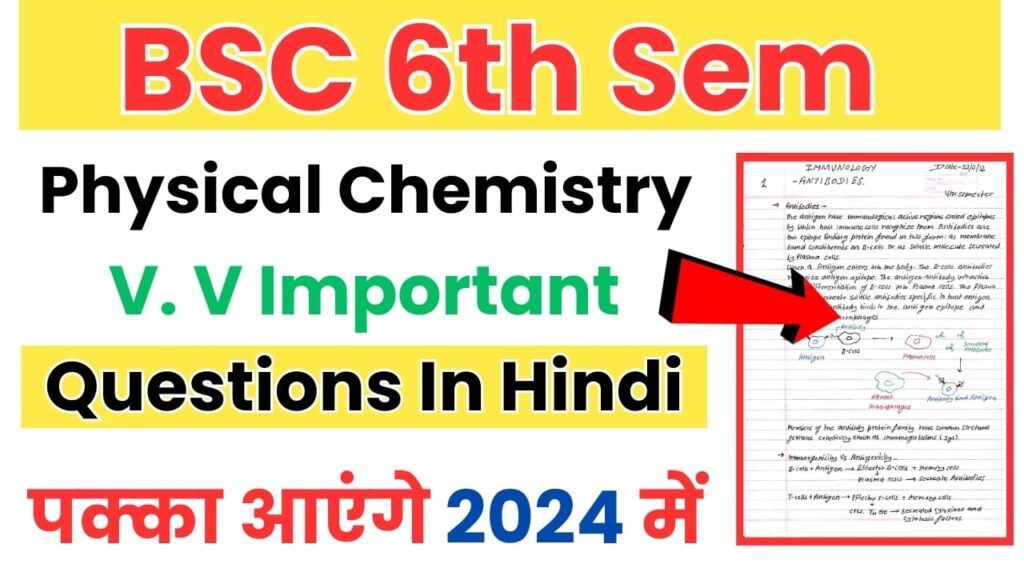
Q1: प्रतिप्रध्वंशीकरण की प्रक्रिया के सिद्धांत को समझाइए। (Explain the principles of thermodynamics.)
Q2: गेल्स क्या हैं और उनकी विशेषताएँ क्या हैं? (What are gels and what are their characteristics?)
Q3: डाल्टन के सिद्धांत को समझाइए और इसके उल्लेखनीय सीमितताएँ बताइए। (Explain Dalton’s law and mention its significant limitations.)
Q4: अन्योन-अन्योन इंटरैक्शन और अनुभूति का मापन कैसे किया जाता है? (How are anion-anion interactions and experience measured?)
Q5: विशेष सामान्यतः उपयोग किए जाने वाले एक्वास इश्यूज़ क्या हैं? (What are special commonly used aqueous solutions?)
Q6: फ्रेंडलिच कांतर के सिद्धांत को समझाइए और उसके आविष्कारक का उल्लेख कीजिए। (Explain the principles of Freundlich adsorption and mention its discoverer.)
Q7: सुधारित मान को समझाइए और इसके उपयोग का वर्णन कीजिए। (Explain the concept of improved value and describe its uses.)
Q8: रासायनिक उत्पादन के लिए खण्डनीय शक्ति क्यों महत्वपूर्ण है? (Why is dissociation energy important for chemical production?)
Q9: तापकीय क्षेत्र के भीतर अद्वितीयता का उल्लेख कीजिए। (Mention the uniqueness within the thermal field.)
Q10: बॉर्न हैबर्ट के नियम क्या हैं और उनका उपयोग क्या है? (What are the Born-Haber rules and what is their use?)
Q11: समस्याएँ जो गैस चरम स्थिति में हैं क्या हैं? (What are the issues in gas extreme conditions?)
Q12: प्रायोगिक गैसों के स्वरूप की उपस्थिति में क्या बदलाव हो सकता है? (What changes can occur in the presence of practical gases?)
Q13: क्वांटम यांत्रिकता के नियमों का उल्लेख कीजिए। (Mention the rules of quantum mechanics.)
Q14: थर्माल स्थिति के परिभाषा को समझाइए। (Explain the definition of thermal equilibrium.)
Q15: अलगाव की अवस्थाएं और उनके प्रकारों का विस्तार कीजिए। (Expand on states of separation and their types.)
Q16: गैस में अनुभवित प्रेशर की मात्रा को किस प्रकार मापा जाता है? (How is the amount of experienced pressure in gas measured?)
Q17: तापकीय गुणों की प्रमुखताएँ और उनके प्रकारों का वर्णन कीजिए। (Describe the main characteristics of thermal properties and their types.)
Q18: अधिकतम संघनित परिपत्रित धारण की सम्भावना कैसे होती है? (How is the possibility of maximum consolidated adsorption assumed?)
Q19: वॉल्टेस नियम क्या है और इसके उपयोग क्या हैं? (What is the Volt’s Law and what are its uses?)
Q20: वन इंडेक्स की परिभाषा को समझाइए और उसका उपयोग कैसे होता है? (Explain the definition of one index and how is it used?)
Q21: तापीय परिवर्तनों की अवस्थाएँ और उनके प्रकारों का विस्तार कीजिए। (Expand on the states of thermal changes and their types.)
Q22: प्रतिरोधी क्षमता क्या है और इसके प्रकार क्या होते हैं? (What is resistance capacity and what are its types?)
Q23: लंबवत संघनित परिपत्रित धारण का अर्थ क्या होता है? (What does the meaning of long-term consolidated adsorption imply?)
Q24: समस्याओं का संग्रह कैसे किया जाता है और इसका उपयोग कैसे किया जाता है? (How are issues collected and how is it used?)
Q25: प्रतिक्रिया के क्षेत्र को समझाइए। (Explain the field of reaction.)
Q26: क्षेत्रीय परिमाण क्या है और इसका महत्व क्या है? (What is local quantity and what is its importance?)
Q27: गैस के तापमान की मात्रा को कैसे मापा जाता है? (How is the temperature of a gas measured?)
Q28: अनुभूत प्रेशर क्या है और यह कैसे प्राप्त किया जाता है? (What is the experienced pressure and how is it obtained?)
Q29: विधुत आवेग क्या है और इसका महत्व क्या है? (What is electric current and what is its importance?)
Q30: अधिकतम रोधी क्षमता क्या है और इसका उपयोग कैसे किया जाता है? (What is the maximum resistance capacity and how is it used?)
BSC 6th Semester Organic Chemistry Important Questions in Hindi
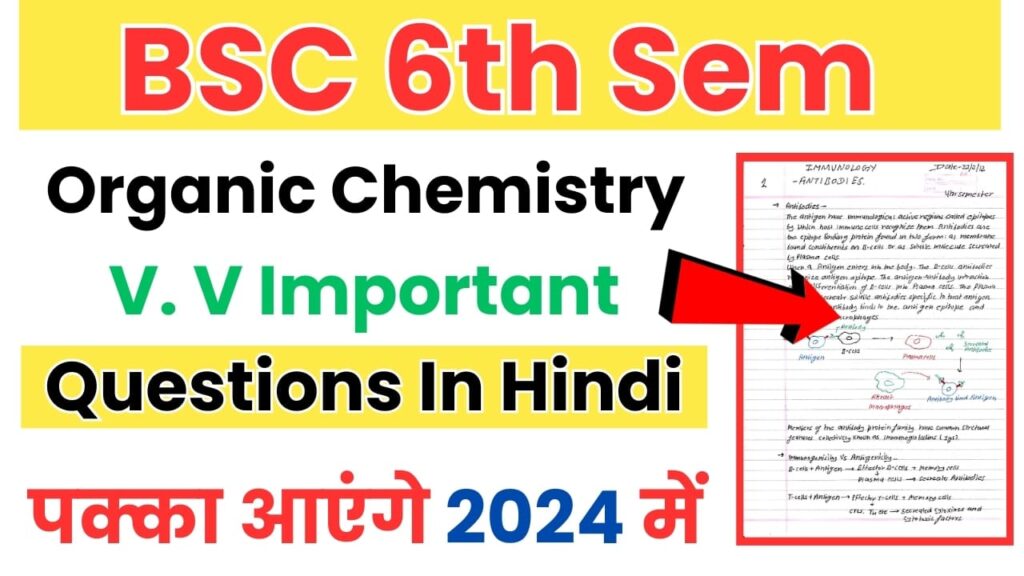
Q1: आल्कोहल और इथर का परिभाषित प्रकार वर्णन कीजिए। (Define Alcohols and Ethers. ) (Alcohols and ethers are described with appropriate definitions.)
Q2: आल्कोहलों की संरचना और विशेषताएँ क्या हैं? (What are the structure and properties of alcohols?) (Discuss the structure and properties of alcohols.)
Q3: एस्टर और केटोन की पहचान कैसे की जाती है? (How are esters and ketones identified?) (Explain the identification of esters and ketones.)
Q4: इसोमेरिज़म क्या हैं? उन्हें समझाएं। (What are isomerism? Explain them.) (Define isomerism and provide explanations.)
Q5: कार्बनिक रेखांकन और उसके प्रकारों की विशेषताएँ बताएं। (Discuss organic nomenclature and its types.) (Describe the characteristics of organic nomenclature and its types.)
Q6: इस्टरीकरण क्या है? इस्टरीकरण के प्रकार क्या हैं? (What is esterification? What are the types of esterification?) (Explain esterification and its types.)
Q7: सुडोमोलेक्यूल और इसके प्रकार की व्याख्या करें। (Explain pseudo molecules and its types.) (Describe pseudo molecules and their types.)
Q8: ग्लाइकोसाइड क्या है? उसके प्रकार और उदाहरण दें। (What is glycoside? Give its types and examples.) (Define glycoside and provide types and examples.)
Q9: कार्बनिक संयोजन और उसके प्रकार क्या हैं? (What is organic synthesis and its types?) (Discuss organic synthesis and its types.)
Q10: आइसोमेरिज़म के प्रकार क्या हैं? (What are the types of isomerism?) (List the types of isomerism.)
Q11: एल्डिहाइड और केटोन के बीच अंतर क्या है? (What is the difference between aldehyde and ketone?) (Distinguish between aldehyde and ketone.)
Q12: आइसोप्रोपाइल आल्कोहल की तैयारी का विवरण दें। (Describe the preparation of isopropyl alcohol.) (Explain the preparation of isopropyl alcohol.)
Q13: उपनामकरण और इसके प्रकार क्या हैं? (What is sub-naming and its types?) (Discuss sub-naming and its types.)
Q14: आल्कीक और आरोमाटिक हाइड्रोकार्बन के बीच अंतर क्या है? (What is the difference between alkyl and aromatic hydrocarbons?) (Elaborate the difference between alkyl and aromatic hydrocarbons.)
Q15: आइसोमेरिज़म क्या होता है? (What is isomerism?) (Define isomerism.)
Q16: एल्कीन, एल्केन और एल्केन की प्रमुख विशेषताएँ क्या हैं? (What are the main characteristics of alkynes, alkenes, and alkanes?) (Discuss the main characteristics of alkynes, alkenes, and alkanes.)
Q17: कार्बनिक रासायनिक संयोजन के लिए विधियों की व्याख्या करें। (Explain methods for organic chemical synthesis.) (Describe methods for organic chemical synthesis.)
Q18: एल्कोहल क्या है? उसके प्रकार और विशेषताएँ बताएं। (What is alcohol? Explain its types and characteristics.) (Define alcohol and discuss its types and characteristics.)
Q19: कार्बनिक और अकार्बनिक यौगिक अलग क्यों हैं? (Why are organic and inorganic compounds different?) (Discuss the differences between organic and inorganic compounds.)
Q20: स्पीडिंग और इसके प्रकार क्या हैं? (What is speeding and its types?) (Define speeding and its types.)
Q21: एल्डिहाइड का नामकरण कैसे होता है? (How is aldehyde named?) (Explain the nomenclature of aldehyde.)
Q22: आइसोमेरिज़म की परिभाषा और प्रकार क्या हैं? (What is the definition and types of isomerism?) (Define isomerism and its types.)
Q23: आरोमाटिक और आश्चर्य यौगिक में अंतर क्या है? (What is the difference between aromatic and miraculous compounds?) (Discuss the difference between aromatic and miraculous compounds.)
Q24: इस्टर क्या है? उसके प्रकार और उदाहरण दें। (What is an ester? Give its types and examples.) (Define ester and provide types and examples.)
Q25: कार्बनिक रेखांकन के प्रकार क्या हैं? (What are the types of organic nomenclature?) (Discuss the types of organic nomenclature.)
Q26: एल्केन की खोज और इसके प्रकार क्या होते हैं? (What is the discovery of alkenes and its types?) (Explain the discovery of alkenes and their types.)
Q27: आइसोप्रोपाइल आल्कोहल क्या है? (What is isopropyl alcohol?) (Define isopropyl alcohol.)
Q28: कार्बनिक रासायनिक यौगिक के प्रमुख उपयोग क्या हैं? (What are the main uses of organic chemical compounds?) (Discuss the primary uses of organic chemical compounds.)
Q29: इथाइल आल्कोहल का नामकरण कैसे होता है? (How is ethanol named?) (Explain the nomenclature of ethanol.)
Q30: सीडीसी, आइसोप्रोपाइल आल्कोहल का नामकरण कैसे होता है? (How is sec-butyl alcohol named?)
BSC 6th Semester Inorganic Chemistry Important Questions in Hindi
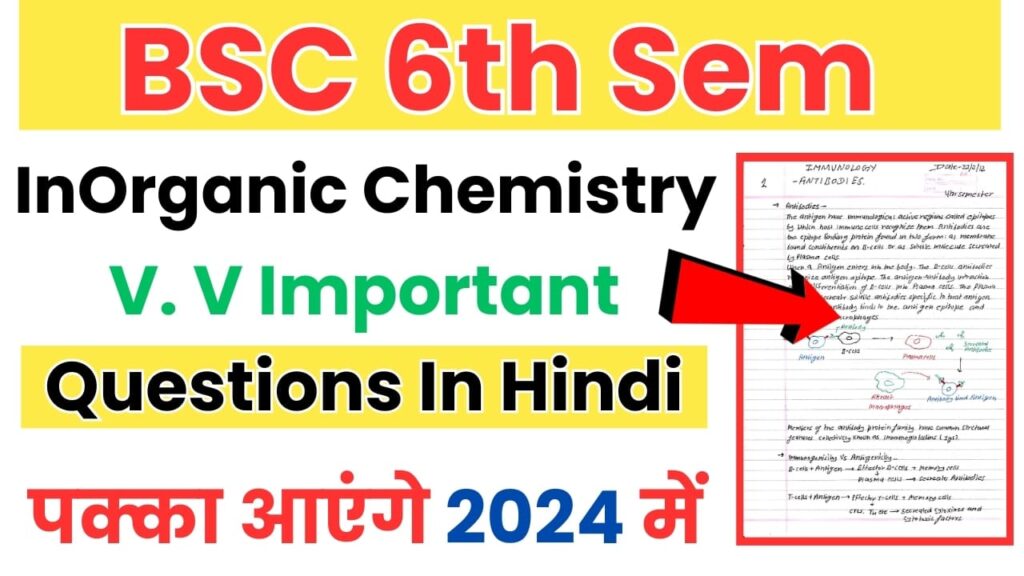
Q1: अभिक्रियात्मक उत्पादन में संकेतकों की महत्वता क्या है? (What is the significance of indicators in volumetric analysis?)
Q2: लैंथनाइड समूह के धातुओं की विशेषताएँ क्या हैं? (What are the characteristics of lanthanide metals?)
Q3: निर्देशांकों के आधार पर मैग्नीशियम के लक्षण क्या हैं? (What are the properties of magnesium based on indicators?)
Q4: अभिक्रियात्मक उत्पादन में उपयोग की जाने वाली विभिन्न रसायनिक पदार्थों की विशेषताएँ क्या हैं? (What are the characteristics of various chemical substances used in volumetric analysis?)
Q5: क्रोमियम और उसके यौगिकों के लक्षण क्या हैं? (What are the characteristics of chromium and its compounds?)
Q6: स्वर्णात्मक और धातुओं की तुलना करें। (Compare noble and base metals.)
Q7: चालकों और अचालकों के बीच अंतर क्या है? (What is the difference between conductors and insulators?)
Q8: उर्वरकों की उपयोगिता क्या है? (What is the utility of fertilizers?)
Q9: सांध्यिकी नामक प्रक्रिया का महत्व क्या है? (What is the importance of the Sandmeyer reaction?)
Q10: चल्कोजनी पदार्थों के लक्षण क्या हैं? (What are the characteristics of ferrous substances?)
Q11: अविकारी तत्वों का उपयोग कहाँ होता है? (Where are inert elements used?)
Q12: विभिन्न धातुओं की तरलता क्या होती है? (What is the ductility of different metals?)
Q13: परमाणु और परमाणु संरचना में क्या अंतर है? (What is the difference between atoms and atomic structure?)
Q14: अद्भुत धातु की पहचान कैसे की जाती है? (How is the identification of precious metal done?)
Q15: रेडियो धातुओं की विशेषताएँ क्या हैं? (What are the characteristics of radioactive metals?)
Q16: उत्तेजक तत्वों का उपयोग क्या होता है? (What is the use of excitatory elements?)
Q17: इलेक्ट्रॉन की गति क्या होती है? (What is the velocity of an electron?)
Q18: धातु और उसके यौगिकों में किस तरह के रासायनिक प्रक्रियाएँ होती हैं? (What kinds of chemical processes occur in metals and their compounds?)
Q19: एक्साइड और उसके प्रकार क्या होते हैं? (What are oxides and their types?)
Q20: विभिन्न धातुओं के धातुवीय गुण क्या होते हैं? (What are the metallic properties of various metals?)
Q21: नियमक तत्वों का उपयोग कहाँ होता है? (Where are regulatory elements used?)
Q22: उत्तेजित कार्बन क्या है? (What is excited carbon?)
Q23: संयोजन और विभाजन में अंतर क्या है? (What is the difference between combination and division?)
Q24: उत्तेजित अम्ल क्या होता है? (What is excited acid?)
Q25: विशिष्ट रेडियोधातुओं की विशेषताएँ क्या हैं? (What are the specific characteristics of special radioactive metals?)
Q26: कैसे प्रमाणित किया जाता है कि एक धातु स्वर्ण है? (How is it verified that a metal is gold?)
Q27: धातु के उत्तेजित पदार्थ क्या होते हैं? (What are the excited substances of metal?)
Q28: धातु क्या है? (What is metal?)
Q29: इलेक्ट्रॉन क्या होता है? (What is an electron?)
Q30: अपरिवर्तनीय तत्व क्या होते हैं? (What are inert elements?)
Also Read: BSC 2nd Semester Chemistry Important Questions in Hindi 2024! रटलो 90% यही आएंगे
BSC 4th Semester Chemistry Important Questions in Hindi 2024!
BSC 3rd Semester Chemistry Important Questions in Hindi 2024! रटलो 60% यही आएंगे
हमें उम्मीद है कि इस लेख की मदद से आपको BSC 5th Semester Chemistry Important Questions in Hindi 2024 के बारे में जानकारी मिल गई होगी।
दोस्तों आपको यह पोस्ट कैसी लगी कृपया हमें कमेंट सेक्शन में बताएं और यदि आपके कोई प्रश्न हों तो बेझिझक हमसे Comment Box में पूछ सकते हैं। यदि आपको यह पोस्ट उपयोगी लगी तो कृपया इसे दूसरों के साथ साझा करें।